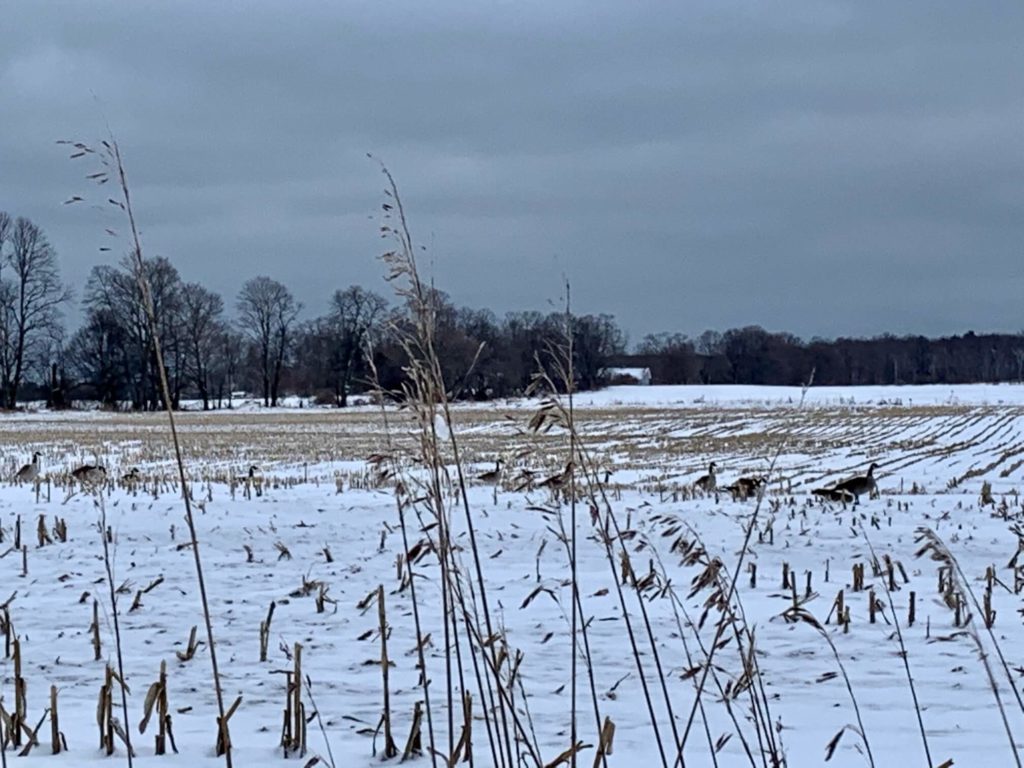
Canada geese rest in a field near Sister Bay.
Crunch. Crunch. Crunch. Frosty air whispers over my cheeks. The forest is otherwise silent, and my boots seem to thunder on the packed snow. Winter has transformed the familiar landscape, and my eyes instinctively search for color and movement in the black and white scene. Crunch. Crunch. My steady pace and the cool air lull me into the calm of the woods. Crunch. What was that I heard? I pause, mid-step, interrupting my own trance. Holding my breath, I listen. Tap tap tap tap tap tap tap. The staccato sound reverberates through the trees. Keeping my feet planted, my head swivels excitedly, scanning branches for the source of the sound. Before I can locate it, a mellow cuk-cuk-cuk-cuk-cuk rings out, rising and falling away. Then, my eyes finally perceive movement, a quick undulation and tucking of black wings, and then the pileated woodpecker has landed, cleverly concealing himself behind a trunk.
Once it is clear the flighty woodpecker will remain hidden, I continue on my walk, stepping gingerly to convince myself I’m not making too much noise. Not even an amateur bird watcher by any measure, even I can appreciate the sighting of this impressive, red-crested bird. The pileated woodpecker is one of many birds that remain part of Northern Door County’s landscape year-round. Birders of all experience levels have long known that this area has prime bird watching, especially in the winter.
Many of the non-migratory songbirds that choose to make Door County their home are easily recognizable. Look for them fluttering through the forest and noshing cheerfully at feeders.
|
|
Soaring higher in the sky or sitting sedately on a lofty perch you’ll find birds of prey. The red-tailed hawk, bald eagle, American kestrel and osprey are the larger birds to keep and eye out for.
Also prevalent are turkeys; look for their three-toed tracks in clusters, left as they travel and forage in the woods. Canada geese and several types of ducks, including buffleheads and mergansers can also be sighted. Herring gulls tend to winter here, and Iceland and glaucous gulls may visit during the cold season as well. Last but not least is the crow, easy to spot against the whiteness.
Truly, there are few places to be in Door County where one couldn’t bird watch, but I argue these are the prime spots. Birding with the Visitor’s Bureau birding guide may help with identification.
The Ridges Sanctuary nature preserve in Baileys Harbor boasts an incredibly diverse ecosystem of marshes, ridges, swales, lakefront and forest, and equally diverse bird population.
Distance from the Blacksmith Inn: Walkable in 1 minute (400 feet)
Cost: $5 nonmembers
Newport State Park is home to many birds, including large birds of prey who hunt along Lake Michigan’s shoreline. Lucky birders may even sight the occasional tundra swan that chooses to overwinter or even a flock of swans migrating in early spring.
Distance from the Blacksmith Inn: Driveable in 27 minutes (19.5 miles)
Cost: Vehicles must have a Wisconsin state parks sticker
Washington Island’s location makes it a gold mine of migratory and year-round bird sightings. Hop a ferry for a day of birding on the water and on land. Washington Island Ferries publishes an extensive birding guide.
Distance from the Blacksmith Inn: Drive and then take the ferry to the island in 1 hour, 10 minutes
Cost: $53.00 for two adults and one vehicle to take the ferry round-trip
To get a closer look at birds of prey, including owls, visit the Open Door Bird Sanctuary in Jacksonport. This preserve is home to un-releasable large birds, like merlins, barred owls, great-horned owls, a vulture, hawks and more. The sanctuary is closed to the public during the winter, but opens on Saturday, March 1st for an open house, trail use and introductions to the raptors.
Distance from the Blacksmith Inn: Driveable in 15 minutes (10.7 miles)
Cost: $3 for the public
Birding is a rewarding pastime and virtually free to start. To go out winter birding in Northern Door, you really just need warm clothes and alert eyes. To enhance your experience, bring snowshoes, binoculars and your favorite Wisconsin bird book. Finally, book a room at the Blacksmith Inn on the Shore, where your view from your balcony allows you to bird in the warm with a hot cup of tea. Check our availability here for your birding adventure.





